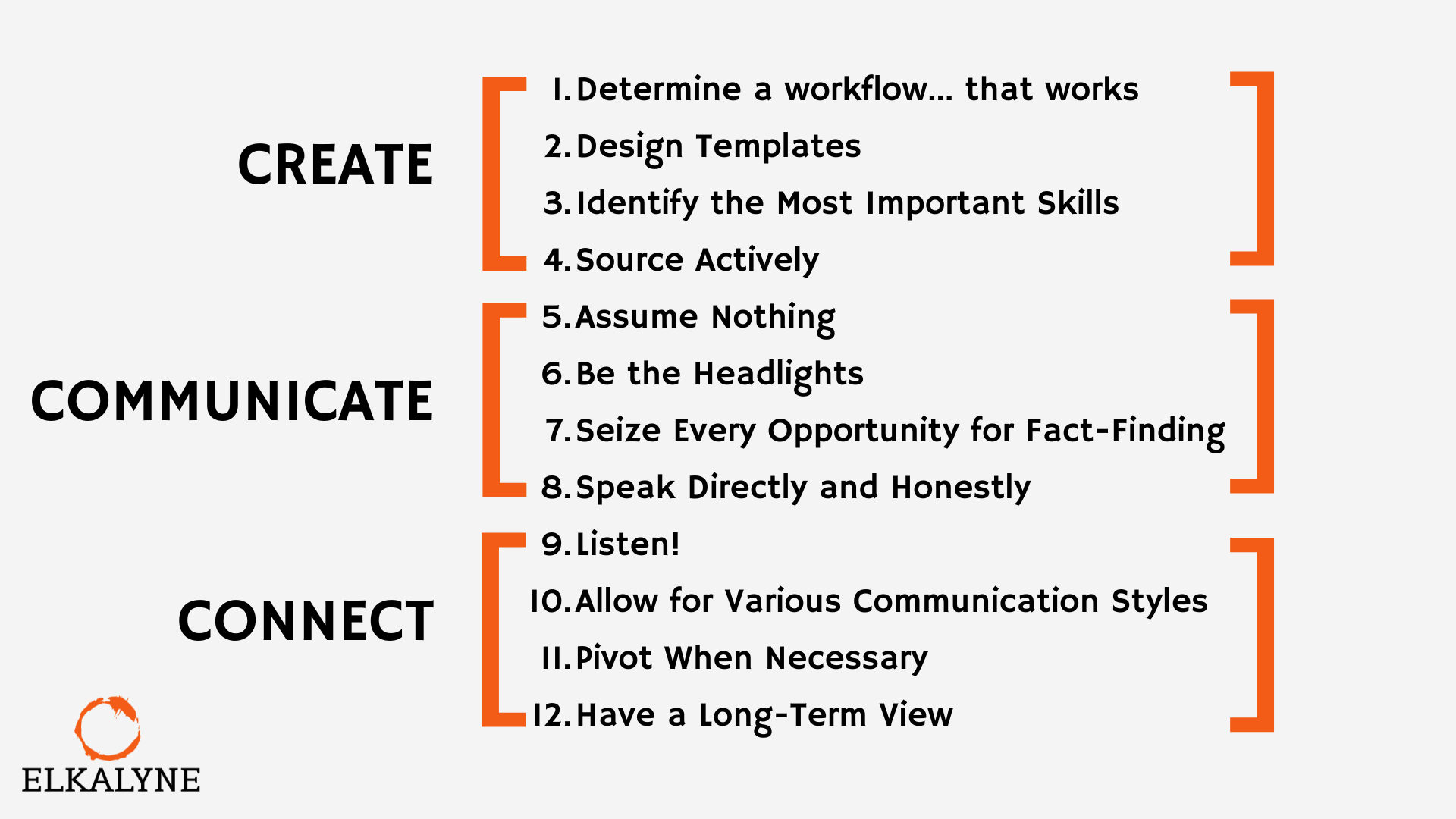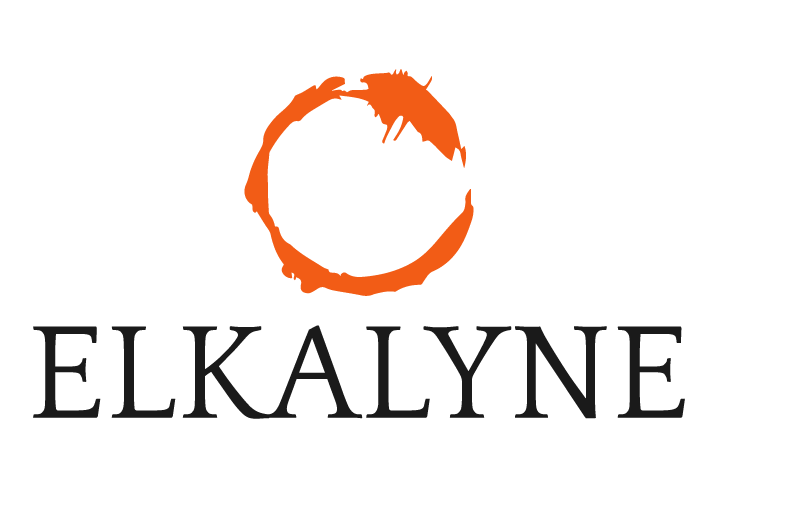In mainstream conversations about hiring challenges, much of the focus is on talent attraction. What incentivizes a candidate to consider working for your company specifically? These are very important conversations -- about compensation, benefits, culture, learning and development, and more. These topics are important, but only relevant to your candidates once they walk through the door of your organization. Discussed less often is the nuts and bolts of your recruiting process – how the candidate gets to the door in the first place.
The recruiting process is primarily a process of dealing with other people, which always leaves room for unpredictable factors. However, there are small changes you can make that increase the likelihood of success in making the necessary hires.
ELKALYNE’s approach to hiring can be summarized by The Three C’s: Create a process. Communicate constantly. And Connect with the individual. Our three c’s break into 12 smaller steps. Read more below!
CREATE A PROCESS
Small Step #1: Determine a Workflow that Works
Determining a workflow is simple but it is not easy. It is simple, because it is just determining WHO is going to do WHAT and WHEN. But it is not easy, because it can often be overwhelming to know where to start. You might be in the early days of your company and sort of meaning to put a workflow together, but then you got so busy and the more hires that were made, the more overwhelming it seemed to formalize the process. Or maybe you have taken the time to actually formalize a workflow, but now it's just gathering digital dust in a file somewhere?
It's easy to think that a solidified workflow is a nice but not necessary thing to have. However, even the smallest detail falling through the cracks can have significant consequences down the line. For example, if you skip the step confirming a candidate’s salary requirements, you could get to the very end of the interview process before realizing you’re not aligned.
To keep your workflow “working,” we recommend considering it a living, breathing document that is regularly revisited to ensure it still reflects your team’s processes.
Small Step #2: Source Actively
I know it sounds easier to post a job and let people find you.
ELKALYNE does not employ the “post and pray” approach, but for an experiment, I posted one of our open roles on Indeed for about 24 hours.
We got over 100 "applications."
- about 20% were bots or otherwise not real people
- about 20% were real people whose experience could hardly have been less relevant to the role posted
- about 20% were outside the united states or required sponsorship the client was unable to provide.
That still left 40 applications to go through and review for skills and experience. In the time it takes me to eliminate 60 applications, read through 40, and select a handful I’d like to reach out to: I can send at least 30 outreach messages on Linkedin to candidates of my choice. even if only 5 respond and are interested, that's still 5 that i've selected based on my nuanced understanding of the role.
5 candidates you’ve chosen > 100 you haven’t.
Small Step #3: Identify the Most Important Skills
Everybody is going to have a different approach to compiling a job description. However, often times, they are created based on a generic understanding of the role rather than a nuanced understanding of what that specific company and team need at that specific time.
To determine the most important skills, take this statement:
“It simply will not work if this candidate cannot ________”
Fill in the blank two or three times with a hard skill (tool proficiency, certification, industry background) and then two or three times with a soft skill (communication style, leadership approach). This will save you a lot of time deciding if you’d like to move a candidate forward in the process, and it will also open up your candidate pool to people you may not have been expecting to be a part of it.
Small Step #4: Design Templates
If you’re going to follow a process and be sending the same emails, linkedin messages, and having the same phone calls over and over again, there’s no need to reinvent the wheel each time.
Templates are a great way to save time, energy, and also to easily hand off work to other team members who don't normally do the work you do day-to-day. Make life easy for yourself.
These four small steps will help you Create a Process. However, your process will not be as useful if you don’t:
COMMUNICATE CONSTANTLY
Small Step #5: Assume Nothing
If you need an answer to a question, ask it. Don’t assume you know the answer.
Let’s say you’re a recruiter working with a hiring manager who has historically wanted their team members to work onsite, so when a new role opens up, you don’t confirm with them whether the role is open to remote candidates. After months of unsuccessful interviews, the hiring manager wants to know why it’s been so difficult to find quality candidates. You share that there are limited options within commuting distance for this role, and the hiring manager is surprised to learn you’ve only been considering local candidates. A lot of time could have been saved by asking one simple question!
Small Step #6: Be the Headlights
Every recruiter, every company, every industry, every job is different, and the length of interview processes and frequent lack of communication is a big deal to candidates.
Imagine you’re driving in the dark. Your headlights help you see the next 200 feet. They don’t show you the whole way, but they show you the next part you need to know.
If you haven’t been a job seeker lately, it might be hard to remember that it feels like driving in the dark. And you can’t be the whole map or a fortune teller, but you can be headlights for candidates (or other stakeholders). Clearly communicate: “this is what’s happening now and this is what will happen next.”
Small Step #7: Seize Every Opportunity for Fact-Finding
Opportunities for fact-finding can be created. Perhaps you’re a recruiter partnering with a hiring manager and due to both of your busy schedules, you can often go days or even weeks without having a conversation longer than 5 minutes. Try scheduling a 15-min weekly call to stay updated on the hiring process, keep it moving, and hold all parties accountable.
However, not all opportunities need to be created to be useful. Unplanned phone calls happen, emails are sent, you walk by somebody’s desk, whatever it is: make the most of it. It’s the “While I Have You” approach, and it can be used with both hiring managers or other hiring stakeholders as well as with candidates.
- “While I have you, Is the initial salary range we discussed for this role still comfortable?”
- “While I have you, are you in late-stage interviews with any other company?”
- “While I have you, it seems like you as the hiring manager hasn’t been as receptive to candidates without industry experience, do you think that’s a priority for you?”
Don’t let any opportunities for communication go to waste.
Small Step #8: Speak Directly and Honestly
As hard as it may be to say no to someone, it's kinder to let them know where they stand and free them to go on their way. It may be tempting to end a candidate screen with “Sure, okay, I’ll get back to you!” even when you have no intention of getting back to them. When this happens, the candidate will continue following up and you will eventually have to figure out a way to cut them loose anyway. It’s not a good use of anyone’s time.
As uncomfortable as it may be to say directly to a candidate, “you’re not the right fit for this role,” it’s likely the candidate will respond with gratitude for respecting their time. Clarity is kindness.
These four small steps are what we recommend to up your communication game. Because after all, hiring is people work and with people we want to:
CONNECT WITH THE INDIVIDUAL
Small Step #9: Listen!
It’s easy to speak to a candidate on the phone, with your checklist and most important skills pulled up on your computer screen, and have a 2-dimensional experience of the person you’re speaking to. While it is faster and easier in the short run to only view that person through the lens of your job description, in the long run it does not serve the purpose of relationship-building and evaluating the person as a whole.
For example: perhaps a candidate you’re interviewing has been with their current company for a long time. Don’t limit your questions to their experience and compensation requirements. Even if they check off every box, they still might require further conversation and reflection to be ready to leave their current organization.
Listening is a craft, and the more you practice, the better you’ll get.
Small Step #10: Allow for various communication styles
With a different individuals come different approaches to communication, so allow for various communication styles. In my ideal world, people respond to my emails within an hour and I never have to pick up the phone. Some people’s ideal world is to get rid of email completely. Our ideal worlds rarely come to fruition, so then what. Even if your workflow has you making a call to a candidate but you know they’ll only respond to an email, send the email. If your workflow has you emailing a hiring manager but you know you’ll get a faster answer if you call, make the call. Being willing to flex on your communication style increases the likelihood that the hire will come through.
Small Step #11: Pivot When Necessary
You may not realize how often ego is the thing that gets in the way of a smooth and efficient hiring process. Whether you're the hiring manager finding it difficult to admit that what you thought you needed for this role is not quite hitting the mark; or you're the one screening candidates and you don't have the subject matter expertise yet to understand whether a candidate is more skilled in front-end or back-end programming; or you're the recruiter really confident about a candidate you've submitted and the hiring manager is just not interested in speaking with them, are you willing to say "I might have this wrong”?
If you’re willing to change your mind when necessary, you might just meet the candidate you didn’t know you needed.
Small Step #12: Have a Long-Term View
One way to put aside your ego is to think of the candidate, the hiring manager, the team, the company, beyond the initial hire and into the future. This can be tricky because you can’t tell the future, nor should you try. However, you can learn to trust your gut when it tells you that someone is not the right fit. As desperate as you may be to fill a role, forcing a fit may seem like a short-term solution but will end up costing time, money, and energy in the long-term.
When trying to get your candidate to the door, it’s important to pay attention to the details. This is by no means a comprehensive list of everything that can be done to ensure a smooth and successful hiring process, but they are the small steps that make a big difference.


